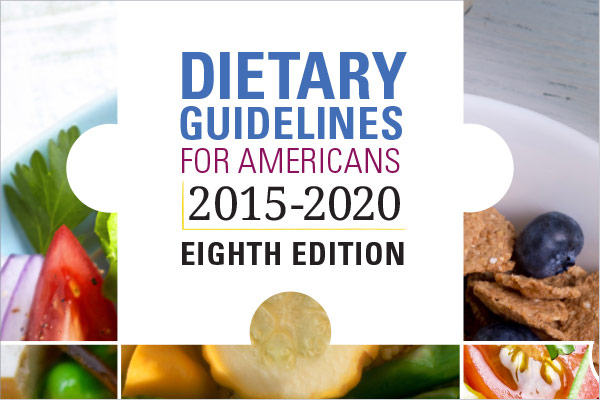A REVIEW OF THE DIETARY GUIDELINES 2015 – 2020
by Dr. Neville Wilson
The 2015 Dietary Guidelines for Americans were published in January 2016, and are the 8th edition released since 1980.
Although these dietary guidelines are prepared every 5 years for the purpose of informing and guiding professionals in the health and nutrition industry in America, they serve also to influence nutrition policy globally, and are highly influential in shaping dietary policy in the UK and Ireland.
Previous Dietary Guidelines have served to shape the dietary recommendations of the United Stated Department of Agriculture, which has in turn influenced National Dietary Policy and recommendations in Ireland and other western countries.
While the Guidelines are intended to make nutrition recommendations based on the best available scientific research, their policy statements are never without controversy, with frequent criticisms of intentional bias, and the selection or exclusion of studies to suit their agenda, while pandering to the dictates of external professional bodies like the American Heart Association (AHA) and the American College of Cardiology (ACC)
The Scientific Report of the 2015 Dietary Guidelines (1) is a summary of the conclusions obtained by the Dietary Guidelines Advisory Committee (DGAC), which relied on material contained in a newly established Nutrition Evidence Library (NEL) (2)
The DGAC have not escaped criticisms of being influenced by the powerful food and drug industries, who view the Guidelines as an opportunity for policy or product promotion.
Added to these criticisms are those pertaining to conflict of interest, and of DGAC members receiving substantial grants from several well known commercial producers of popular dietary items.
ARE THE GUIDELINES BASED ON GOOD SCIENCE ?
In a British Medical Journal report (23 September 2015) author Nina Teicholz raised important questions about the Guidelines Committee’s omission of crucial and updated material regarding saturated fats, carbohydrates, and sugar, and their dietary impact on health, with particular reference to heart disease, diabetes and obesity. (3)
The criticisms contained in the BMJ report were refuted by the Guidelines Committee, who called for a retraction of the BMJ article, citing it’s accusations as being invalid.
The demand for retraction was issued by the Centre for Science in the Public Interest,(CSPI) but was denied by the BMJ, following a referral to two independent research experts, who recommended that the article be not retracted, since it’s criticisms were validated by the scientific evidence.
The BMJ article was shown to have valid criticisms of “conflict of interest” and of “methods being out of date and lacking sufficient detail, which could have introduced bias”. (3)
THE DIETARY GUIDELINES 2015:
An outline of the previous DIETARY GUIDELINES 2011 received a critical response from me for its promotion of a reduction in dietary saturated fat intake, and an excess of refined carbohydrates, as portrayed in the traditional food pyramid. (4)
The 2015 Guidelines offer 3 chapters of policy, followed by lists of supporting tables and figures.
Chapter 1 lists 5 Dietary Guidelines as being the key elements of healthy eating patterns. In summary they are as follows:
(1) Follow a healthy eating pattern across the lifespan.
(2) Focus on variety, nutrient density, and amount.
(3) Limit calories from added sugars and saturated fats and reduce sodium intake.
(4) Shift to healthier food and beverage choices.
(5) Support healthy eating patterns for all.
On the surface these 5 guidelines appear to be reasonable and acceptable, but as often is the case, the devil is in the detail.
Item 3 calls for a reduction in saturated fats, which is no change from previous guideline recommendations, with the same recommendation to consume less than 10% of total calories from saturated fat daily.
From as far back as the 1980 Guidelines only low fat and lean meat was considered to be heart healthy.
The new Guidelines call for a shift in choices from those high in saturated fats to those high in polyunsaturated fats and monounsaturated fats, and choosing lower fat forms of food such as fat free, or low fat milk instead of 2% or whole milk, or regular cheese and lean rather than fatty cuts of meat.
The current guidelines recommend to limit the intake of calories from saturated fats to less than 10%, stating it “is a target based on evidence that replacing saturated fats with unsaturated fats is associated with a reduced risk of cardiovascular disease.”
The “evidence” for this claim is controversial, and conflicting, , despite the fact that a 2010 meta-analysis of prospective cohort studies evaluating the association of saturated fat with cardiovascular disease found “no significant evidence for concluding that dietary saturated fat is associated with an increased risk of coronary heart disease (CHD) or cardiovascular disease (CVD)” (5)
This comprehensive review included studies conducted over the past 50 years involving 347,747 subjects.
In a 2012 Cochrane Database Review a reduced or modified fat intake was found not to prevent cardiovascular disease (6)
And in a 2014 systematic review and meta-analysis dietary and circulating fatty acids were not associated with risk for coronary heart disease. (7)
In this item, sugar, saturated fat and salt are all lumped together.
There is no similarity between these 3 dietary options, but they have for so long been branded as the triplet dietary culprits that some Irish dieticians have coined the slogan FSS (fat, sugar, salt) as the dietary villains.
I have previously criticized the promotion of this slogan as being misleading and unhelpful.
In my REVIEW OF THE 2011 DIETARY GUIDELINE I referred to some of the biochemical and nutritional advantages of saturated fats. (4)
The current 2015 Guidelines do not restrict total fat intake, despite the recommended restriction on saturated fat intake.
A non-restricted fat intake, with reduced saturated fat, opens the door for poly-unsaturated fat excess, and a diet unrestricted in omega-6 vegetable oil intake, which has been shown to generate inflammatory mediators with increased risk for atherosclerosis. (8)
The current Guidelines do not place a limit on the consumption of red meat, but do repeat previous recommendations to choose lean meats, seafoods and nuts.
The Guidelines call for a moderate intake of alcohol.
CHOLESTEROL :
The 2015 Guidelines do not repeat the previous warnings about dietary cholesterol as a risk factor for heart disease, thereby acknowledging that previous recommendations to restrict cholesterol intake was unsupported by the totality of evidence.
SUGAR :
In the 5 Guidelines, Item 3 calls for a limit to the intake of calories from added sugar to less than 10%, but fails to warn about the potential for sugar intake from unrestricted simple carbohydrates present in some fruits and grains.
SALT :
The Guidelines recommend a limitation to the intake of sodium to less than 2,300 mg per day for individuals over the age of 14 years.
In the 5 Guidelines, Item 4 calls for a shift to healthier food and beverage choices, which are nutrient dense, and a consideration of cultural and personal preferences to make these shifts easier to accomplish and maintain.
These recommendations are supportive of good health, but somewhat open to individual interpretation.
Diet and Nutrition :
The Guidelines promote a Healthy-Mediterranean Style Eating Pattern, with increased fruit and seafood intake (Appendix 4) and a healthy Vegetarian Eating Pattern (Appendix 5) with “more legumes, soy products, nuts and seeds and whole grains”.
Underconsumed Nutrients of Public Health Concern are reported as potassium, dietary fibre, choline, magnesium, calcium and vitamins A,D,E and C, largely due to low intakes of the food groups, vegetables, fruits, whole grains and dairy.
Particular reference is made to underconsumed calcium, potassium, dietary fibre and Vitamin D because of their association with health concerns.
(Of note is the absence of Vitamin K2 as a vital nutrient for bone health).
While no specific mention is made of the protective role for omega 3 marine oils, the recommended inclusion of sea food providing EPA and DHA is listed.
The Guidelines do not recommend supplementing with nutritional supplements to achieve targets essential for good health, and recommend nutrient-dense foods to achieve these objectives.
While these Guidelines have been specifically prepared for the American public, it is likely that similar recommendations and restrictions will be incorporated into local national dietary guidelines.
The relevance and application of these dietary recommendations to local populations will undoubtedly be a source for continuing debate.
Dr. Neville Wilson.
30 August 2016.
REFERENCES :
- http//health.gov/dietaryguidelines/2015-scientific-report.
- www.nel.gov/faq
- BMJ 2015;351 doi:https://doi.org/10.1136/bmj.h4962.
- A Review of the 2011 Dietary Guidelines – www.drnevillewilson.com
- Am J Clin Nutr 2010, 91;535-46, Siri-Tarino PW et al.
- Cochrane Database Syst Rev 2012;5:CD002137
- Intern Med 2014: 160:395-406
- J Clin Endocrinol Metab 91; 439-446, 2006. Ferruci L et



